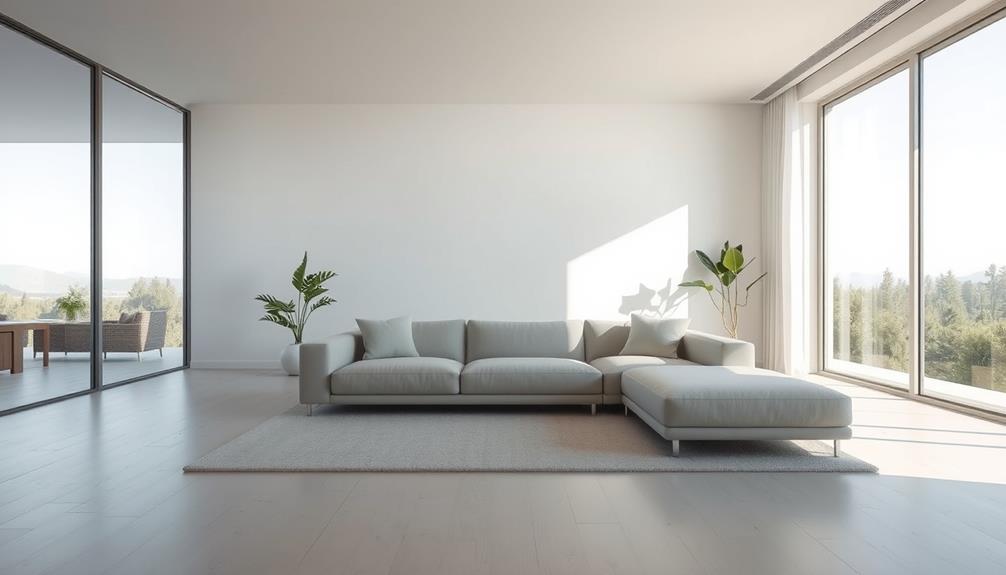You can update your home with minimalist trends that prioritize simplicity and functionality. Begin by organizing your space to emphasize quality over quantity. Opt for versatile furniture crafted from natural materials for a cozy feel, and stick to a neutral color scheme for a peaceful ambiance. Thoughtful lighting, like modern fixtures and natural light, can enhance your surroundings. Integrate smart technology to streamline daily tasks and enhance convenience. By embracing these minimalist principles, you’ll create a serene and chic living space that encourages clarity. There are endless possibilities to further elevate your minimalist journey. Consider adding natural elements such as indoor plants or wood accents to bring a sense of tranquility and connection to nature indoors. As you refine your minimalist space, you may find inspiration in minimalist lifestyle practices such as mindfulness and intentional living. These principles can extend beyond your home and into various aspects of your life, including participation in women’s empowerment retreats, where you can gain valuable insights and experiences that align with your minimalist values.
Key Takeaways
- Embrace multifunctional furniture to maximize space and enhance functionality in your living areas.
- Choose a neutral color palette to create a serene and calming atmosphere throughout your home.
- Implement effective lighting solutions by layering ambient, task, and accent lighting for depth.
- Declutter your space to highlight quality over quantity, promoting clarity and focus.
- Incorporate natural materials and clean lines to achieve a harmonious and inviting aesthetic.
Understanding Minimalist Design

Minimalist design is all about embracing simplicity and functionality in your living space. By focusing on clean lines and geometric shapes, you create a harmonious environment that promotes tranquility.
Prioritizing decluttering allows you to emphasize quality over quantity, ensuring your space feels open and spacious. Utilize a neutral color palette—think whites, beiges, and grays—to cultivate a calming atmosphere.
Incorporating negative space is essential; it not only enhances the serenity of your home but also draws attention to key design elements. As you embrace minimalist principles, you'll find that each piece in your space serves a purpose, contributing to a balanced and serene living experience that aligns with your lifestyle.
Simplifying your surroundings can lead to greater peace of mind.
Furniture Selection and Arrangement

Selecting and arranging furniture is essential for achieving a minimalist home that feels both functional and inviting. Start by choosing multifunctional pieces, like a sleek coffee table that doubles as storage. This maximizes space while maintaining a clean look.
Opt for natural materials, such as wood or stone, to add warmth and texture without overwhelming the space. When arranging your furniture, focus on creating balance and flow; avoid overcrowding by leaving purposeful empty spaces.
Position key pieces to accentuate sightlines and guarantee easy movement throughout the room. Finally, keep your color palette neutral to enhance tranquility.
Effective Lighting Solutions

Effective lighting solutions can transform your minimalist home into a serene and inviting space. To achieve this, consider the following three strategies:
- Choose Sleek Fixtures: Opt for minimalist pendant lights and recessed lighting that blend seamlessly with your decor. Their clean lines enhance your home's aesthetic without overwhelming it.
- Layer Your Lighting: Combine ambient, task, and accent lighting to create depth and functionality. Use wall sconces for specific areas, providing both illumination and elegance.
- Utilize Natural Light: Maximize the use of windows and mirrors to reflect daylight, creating a bright and airy atmosphere. This connection to nature fosters tranquility and warmth.
Embracing Smart Technology

In today's homes, integrating smart technology can greatly enhance your minimalist living experience. By automating daily tasks, you simplify your routine, allowing you to focus on what truly matters.
Smart appliances, known for innovative technology and design, such as smart lighting, adjust to your preferences, creating the perfect ambiance while conserving energy. Voice control through devices like Alexa or Google Assistant makes managing your home effortless, keeping your space clutter-free.
Smart thermostats optimize your heating and cooling, ensuring comfort while reducing utility costs. You can monitor and control your home remotely, providing peace of mind.
With seamless integration, each device enhances functionality without overwhelming your minimalist aesthetic. Embracing smart technology not only elevates your lifestyle but also aligns perfectly with the principles of minimalism, promoting simplicity and efficiency.
Exploring Minimalist Styles

Integrating smart technology not only simplifies your daily routines but also complements various minimalist styles that can transform your living space.
Whether you're drawn to Scandinavian simplicity, Japanese tranquility, or modern minimalist flair, each style has unique elements that enhance your home's aesthetic.
Consider incorporating elements of modern farmhouse decor trends for a touch of warmth and authenticity alongside your minimalist approach.
Consider these key features when exploring minimalist styles:
- Clean Lines: Embrace furniture and decor with sleek, geometric shapes to create harmony.
- Natural Materials: Incorporate wood, stone, or bamboo for warmth and a connection to nature.
- Neutral Color Palettes: Use whites, beiges, and grays to cultivate a serene atmosphere.
Advantages of Minimalism

One of the key advantages of minimalism is its ability to create a sense of tranquility in your living space. By embracing minimalism, you not only declutter your home but also clear your mind, allowing for a more peaceful environment. You'll notice that simplicity fosters clarity and focus in your daily life.
| Benefits | Description |
|---|---|
| Tranquility | Creates a calming atmosphere |
| Functionality | Prioritizes practical, multi-use furniture |
| Eco-Friendliness | Encourages sustainable choices and materials |
As you integrate minimalist principles, you'll find that your home promotes well-being while enhancing aesthetic appeal. Ultimately, minimalism leads to a more enjoyable, harmonious living experience.
Achieving a Minimalist Aesthetic

Embracing minimalism not only enhances your home's tranquility but also sets the stage for achieving a minimalist aesthetic.
To create this refined look, focus on three essential principles:
1. Simplicity: Choose furniture with clean lines and simple shapes. Avoid overcrowding by selecting only what you truly need.
Incorporating DIY Fire Pit Ideas can also create a serene outdoor space that complements your minimalist design.
2. Neutral Colors: Opt for a palette of whites, grays, and beiges to cultivate a calm atmosphere. These colors promote a timeless and sophisticated feel.
3. Purposeful Space: Allow negative space to breathe within your home. This intentional emptiness highlights key design elements and fosters a serene environment.
Frequently Asked Questions
How Can I Start Decluttering My Home Effectively?
Start by tackling one room at a time. Set a timer for 15 minutes, sort items into keep, donate, and discard piles, and commit to regular decluttering sessions. You'll notice a significant difference quickly.
What Are Some Affordable Minimalist Decor Options?
You can explore affordable minimalist decor options like thrifted furniture, DIY art, and neutral textiles. Focus on quality over quantity, choose multifunctional items, and embrace nature-inspired elements to create a serene, uncluttered space.
How Do I Maintain a Minimalist Lifestyle Long-Term?
Maintaining a minimalist lifestyle's like tending a garden; you need regular pruning. Keep decluttering, embrace quality over quantity, and prioritize experiences over possessions. Create routines that reinforce simplicity, ensuring your space stays serene and purposeful.
Can Minimalism Work in Small Living Spaces?
Absolutely, minimalism thrives in small living spaces. You'll maximize functionality with multifunctional furniture, embrace decluttering, and create a serene atmosphere. Focus on clean lines and neutral colors to enhance the sense of openness and tranquility.
What Are Common Mistakes to Avoid in Minimalist Design?
When diving into minimalist design, you might overlook essential functionality. Don't clutter your space with unnecessary items; prioritize quality and purpose instead. Avoid over-decorating, as simplicity fosters tranquility and enhances your living environment's overall appeal.
Conclusion
As you step into your transformed space, you'll feel an undeniable sense of calm wash over you. The clean lines and purposeful design whisper promises of clarity and peace. But what if there's more to uncover? What hidden benefits lie within the minimalist lifestyle, waiting for you to discover? By embracing these trends, you're not just reshaping your home—you're starting on a journey that could redefine your entire way of living. Are you ready to explore the possibilities?









